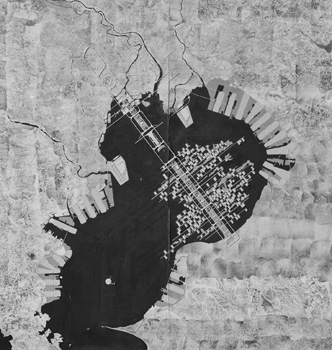A special talk event at TSUTAYA TOKYO ROPPONGI with director of Mori Art Museum Nanjo Fumio, and architect Rem Koolhaas, who had travelled to Japan to attend the symposium organized in conjunction with the exhibition &quo;Metabolism, the City of the Future: Dreams and Visions of Reconstruction in Postwar and Present-Day Japan&quo;. Here is the third installment in a series of five reports by Tokyo Art Beat's Naoki Matsuyama.
---------------------------------------
The book Project Japan is composed of nine interviews and nine chapters on Koolhaas' own interpretation of Metabolism, as well as the key events and themes that are crucial to understanding Metabolism. In this installment, we will look at the characteristics of the book and Koolhaas' particular focus in it, namely the relationship between Metabolism and politics.

Special Talk to commemorate the publication Project Japan: Metabolism Talks...
By Rem Koolhaas and Hans Ulrich Obrist
Photo: Mikuriya Shinichiro
The interviews were the initial reason that prompted Koolhaas to start working on the book in 2005. The sense of alarm that the voices of the Metabolists should be compiled into a record before they were lost forever was a major motivation. This also directly relates to the timing in which the exhibition aiming to define and historicize the Japanese architectural movement had been organized.
In the interviews, Koolhaas was accompanied by art critic and curator Hans Urlich Obrist, known for the prodigious number of interviews he has carried out. The two focused not on making the architects talk about their works, as one would expect from an ordinary interview, but rather on the lives and human relationships among the Metabolists and those around them. Koolhaas' approach is palpable here, in his attempt to understand architecture stereoscopically by casting a light not only on the isolated work itself, but also on the context in which architecture arises. Emblematic of this are the interviews with Tange Kenzo's widow and son, as well as his former family.

Tange Kenzo and his research lab in Tokyo University
A Plan for Tokyo, 1960 1961 Photo: Kawasumi Akio
Courtesy: TANGE ASSOCIATES
Koolhaas: &quo;Without Tange, there would have been no metabolism&quo;
During the talk, Koolhaas praised Tange as &quo;a unique figure not simply as an architect, but as someone who seamlessly integrated his life, education, work and politics, creating an incubator for young architects&quo;. The interviews with his family illustrates the fact that he regarded their points of view as being crucial to attaining a full grasp on Tange's work.
Another unique characteristic of the book is the interview with Shimokobe Atsushi, who held prominent positions as a bureaucrat, including the vice ministerial role at the National Land Agency. Despite having masterminded numerous national land planning projects, and being deeply involved with the Metabolists, the spotlight rarely settles on him. Koolhaas interviewed him twice over a span of three years in order to unravel the connection between architecture and government that existed at that time, in the belief that it constituted one of the defining strengths of Metabolism as a movement.
Shimokobe and the central government had a new vision of Japan and that vision was based on an awareness of Japan's weakness, namely its physical vulnerability and its limited territory. Shimokobe sought to transform Japan in spite of these weaknesses, and the Metabolists played their roles in a script that was written by him and the government.
The Japanese government in fact acted as an incredible sponsor of architects and, in a way, you could even say that they invented certain architects. This is why the book is called Project Japan.
Are we to understand this as a provocative statement suggesting that the real &quo;architects&quo; are the politicians and bureaucrats, with the actual architects being merely their tools? Nanjo cast a light on this question from a different angle: does Koolhaas see Metabolism as a symbolic example of a happy relationship between politics and architects?
We know that there are all kinds of problems with politics. But nevertheless, I'd say that what Metabolism shows is that if there's an intelligent government with an agenda, and a government that is interested in using architects as actors to play within that agenda, you create a very strong situation.
We should not forget the fact that during the talk, Koolhaas mentioned that &quo;without Tange, there would have been no Metabolism&quo;. In fact, Shimokobe was a student at Tange's lab, and he would not have been able to tap into the architectural talent of Metabolism if those young architects had not already gathered around Tange. However, his response does seem to suggest that the leadership of a strong government is essential for architects to be able to contribute to a project of the kind of scale entailed by the building of a nation.
Why did Koolhaas avoid touching on these kinds of topics when answering to the question about the validity of Metabolism today? This will become clearer in our next installment.
■Relevant information
・Rem Koolhaas x Nanjo Fumio
(1) Why Metabolismnow?
Looking back at the period of the Metabolists through the eyes of today
(2) Why Metabolism now?
Is Metabolism a thing of the past for a shrinking Japan?
(3) Metabolism and Politics
Are politicians and bureaucrats the real "architects"?
(4) Architecture Today and Its Problems
What kind of limitations does Koolhaas feel as an architect?
(5) Architecture Today and Its Problems
・"Metabolism, the City of the Future:Dreams and Visions of Reconstruction in Postwar and Present-Day"
17 September (sat), 2011 - 15 January (sun), 2012
・Mori Art Museum on Flickr
"Metabolism, the City of the Future: Dreams and Visions of Reconstruction in Postwar and Present-Day Japan"








